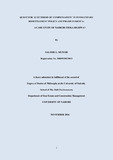| dc.description.abstract | Involuntary resettlement arising from government induced public purpose projects is a thorny policy issue to both the project displaced persons and governments in the associated compensation praxis. Empirical studies by various professionals identify a broad spectrum of socio-cultural and economic drivers that if considered in compensation, would ameliorate the pain so occasioned. In Kenya, the quest for just terms of compensation resonates in land reform ideals that necessitate paradigm shifts in socio-cultural and economic compensation praxis. This study evaluates policy and legal frameworks espoused in the National Land Policy of 2009 and Constitution 2010 with an aim of suggesting a just terms of compensation model in involuntary resettlement policy and praxis in Kenya. A review of policies and compensation praxis of involuntary resettlement in selected countries from Asia (China), Latin America (Brazil) and Africa (Nigeria, South Africa and Zimbabwe) was undertaken for comparison with the Kenyan praxis to assist in identifying attributes of just terms of compensation.
The research design was case study of Nairobi-Thika highway, chosen because of its proximity to cadastre records at the Ministry of Lands Registries at Nairobi and Thika towns. This will save on research time and costs as well as ease access of research assistants to the respondents. The research set up commenced with literature review on policy and compensation praxis contextualised within philosophical discourses on justice that assisted the study on the just terms of compensation phenomenon. This strategy satisfied the objectives of the study by establishing the level of awareness of the legal framework on involuntary resettlement. This assisted in confirming the satisfaction/justness gap in developing a just terms of compensation model for involuntary resettlement.
The population frame was informed by the Kenya gazette listings, prepared by the acquiring body that contain listing of registered land parcels affected by the highway. The registered proprietors were confirmed using records from the offices of Ministry of Lands at Nairobi and Thika registry offices. Listings for three categories were drawn from the population frame to form the strata categories comprising households, small and medium enterprises and institutions affected by the project. This formed the sampling frame from which the households and small and medium enterprises were randomly chosen on a 50% sample size while a survey was made for category with ≤ 50 elements comprising of institutions. A forth
xv
category of respondents identified as the policy makers/implementers was drawn from implementing agencies to allow for a representative outcome of the study.
The data collection instrument was a semi-structured questionnaire that doubled as an interview guide having a section with open-ended questions for clarity and in-depth information. The questionnaire highlighted justice in the legal framework on compensation praxis in Kenya to satisfy objective one, the level of awareness of the legal framework on just compensation to satisfy objective two and a review of the human rights based approaches and Cernia‟s (1999) eight-tier social disarticulation model for a combined prism that developed a just terms of compensation model. Tests of construct validity and content reliability were undertaken on a pilot test and a Cronbach Alpa of 0.7% established reliability of the data collection instrument. The collected data was codified and analysed using SPSS Version 20 for subjection to mixed data analyses strategy comprising of Analysis of Variance, Multiple Regression and the Pearson Multivariate Correlation techniques. This enabled quantitative data to support the qualitative analysis using cross tabulation and triangulation for reliability of the findings.
The research findings indicated that the policy frameworks and compensation praxis in involuntary resettlement in Kenya fell short of Article 40 on Constitutional provision of „prompt payment in full of just compensation‟. The study highlights the need for inclusion of socio-cultural and economic attributes in compensation praxis suggest in the parameters of just terms of compensation in involuntary resettlement. These parameters recognized communal secondary derivative attributes dependent on land, shelter and shared natural resources anchored on familial socialization within the constitutional tenure classification of public, private and community lands. In conclusion, the null hypothesis was adopted that just terms of compensation are not adequate in policy framework on involuntary resettlement in Kenya. The study suggested a just terms of compensation conceptual model converging the legal framework applied by economist-valuation methods and sociological approaches as the tributary consummating the policy framework to support the model. | en_US |



